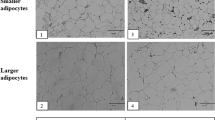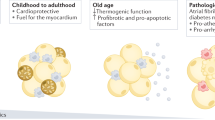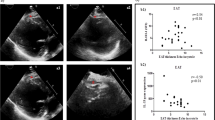Abstract
Low plasma adiponectin levels are related to a higher risk of development of metabolic and cardiovascular disorders, including hypertension (HT). To date, there have been no studies supporting the relationship between epicardial adipose tissue (EAT) expression of adiponectin and HT. We collected samples of EAT from 116 patients undergoing elective cardiac surgery, mostly for coronary artery bypass grafting (n=54), valve surgery (n=49) or both (n=12). Samples of subcutaneous adipose tissue (SAT) were harvested from 85 patients. After RNA isolation, the expression of adiponectin was analysed by real-time retrotranscriptase (RT)-PCR. Baseline clinical data were obtained from medical records. The diagnosis of HT was established mostly by the patients’ general physicians following current guidelines. We included 84 hypertensive and 32 non-hypertensive patients. Mean (±s.d.) age was 70.3±7.9 years. EAT expression levels of adiponectin were lower in hypertensives (14.0±3.6 vs 15.3±3.6 arbitrary units (a.u.), P=0.06). This difference was statistically significant (odds ratio (OR) 0.828 per a.u., P=0.020) after adjustment for age, gender, body mass index, diabetes mellitus, heart failure, coronary artery disease (CAD), total cholesterol and triglyceride levels. However, SAT adiponectin mRNA levels were similar in hypertensive and non-hypertensive patients (15.3±4.2 vs 15.3±5.0 a.u., P>0.99). Adjustment for potential confounding factors hardly altered this result. Our findings indicate that EAT expression of adiponectin may be associated with HT status independently of CAD or other comorbidities, whereas SAT expression does not. These results support the hypothesis that EAT is actively implicated in global cardiovascular risk, describing its association with HT.
This is a preview of subscription content, access via your institution
Access options
Subscribe to this journal
Receive 12 digital issues and online access to articles
$119.00 per year
only $9.92 per issue
Buy this article
- Purchase on Springer Link
- Instant access to full article PDF
Prices may be subject to local taxes which are calculated during checkout



Similar content being viewed by others
References
Mazurek T, Zhang L, Zalewski A, Mannion JD, Diehl JT, Arafat H et al. Human epicardial adipose tissue is a source of inflammatory mediators. Circulation 2003; 108: 2460–2466.
Iacobellis G, Pistilli D, Gucciardo M, Leonetti F, Miraldi F, Brancaccio G et al. Adiponectin expression in human epicardial adipose tissue in vivo is lower in patients with coronary artery disease. Cytokine 2005; 29: 251–255.
Lindahl B, Toss H, Siegbahn A, Venge P, Wallentin L . Markers of myocardial damage and inflammation in relation to long-term mortality in unstable coronary artery disease. N Engl J Med 2000; 343: 1139–1147.
Ridker PM, Rifai N, Stampfer MJ, Hennekens CH . Plasma concentrations of IL-6 and the risk of future myocardial infarction among apparently healthy men. Circulation 2000; 101: 1767–1772.
Ridker PM, Rifai N, Pfeffer M, Sacks F, Lepage S, Braunwald E . Elevation of tumor necrosis factor-alpha and increased risk of recurrent coronary events after myocardial infarction. Circulation 2000; 101: 2149–2153.
Trayhurn P, Beattie JH . Physiological role of adipose tissue: white adipose tissue as an endocrine and secretory organ. Proc Nutr Soc 2001; 60: 329–339.
Iacobellis G, Corradi D, Sharma AM . Epicardial adipose tissue: anatomic, biomolecular and clinical relationships with the heart. Nat Clin Pract Cardiovasc Med 2005; 2: 536–543.
de Vos AM, Prokop M, Roos CJ, Meijs MF, van der Schouw YT, Rutten A et al. Peri-coronary epicardial adipose tissue is related to cardiovascular risk factors and coronary artery calcification in post-menopausal women. Eur Heart J 2008; 29: 777–783.
Iacobellis G, Assael F, Ribaudo MC, Zappaterreno A, Alessi G, Di Mario U et al. Epicardial fat from echocardiography: a new method for visceral adipose tissue prediction. Obes Res 2003; 11: 304–310.
Iacobellis G, Ribaudo MC, Assael F, Vecci E, Tiberti C, Zappaterreno A et al. Echocardiographic epicardial adipose tissue is related to anthropometric and clinical parameters of metabolic syndrome: a new indicator of cardiovascular risk. J Clin Endocrinol Metab 2003; 88: 5163–5168.
Ouchi N, Kihara S, Arita Y, Maeda K, Kuriyama H, Okamoto Y et al. Novel modulator for endothelial adhesion molecules. Adipocyte-derived plasma protein adiponectin. Circulation 1999; 100: 2473–2476.
Arita Y, Kihara S, Ouchi N, Takahashi M, Maeda K, Miyagawa J et al. Paradoxical decrease of an adipose-specific protein, adiponectin, in obesity. Biochem Biophys Res Commun 1999; 257: 79–83.
Kishida K, Nagaretani H, Kondo H, Kobayashi H, Tanaka S, Maeda N et al. Disturbed secretion of mutant adiponectin associated with the metabolic syndrome. Biochem Biophys Res Commun 2003; 306: 286–292.
Pajvani UB, Du X, Combs TP, Berg AH, Rajala MW, Schulthess T et al. Structure–function studies of the adipocyte-secreted hormone Acrp30/adiponectin. Implications for the metabolic regulation and bioactivity. J Biol Chem 2003; 278: 9073–9085.
Santaniemi M, Kesaniemi YA, Ukkola O . Low plasma adiponectin is an indicator of the metabolic syndrome. Eur J Endocrinol 2006; 155: 745–750.
Berg AH, Combs TP, Scherer PE . ACRP30/adiponectin: an adipokine regulating glucose and lipid metabolism. Trends Endocrinol Metab 2002; 13: 84–89.
Hotta K, Funahashi T, Arita Y, Takahashi M, Matsuda M, Okamoto Y et al. Plasma concentrations of a novel, adipose-specific protein, adiponectin, in type 2 diabetic patients. Arterioscler Thromb Vasc Biol 2000; 20: 1595–1599.
Nakamura Y, Shimada K, Fukuda D, Shimada Y, Ehara S, Hirose M et al. Implications of plasma concentrations of adiponectin in patients with coronary artery disease. Heart 2004; 90: 528–533.
Wolk R, Berger P, Lennon RJ, Brilakis ES, Davison DE, Somers VK . Association between plasma adiponectin levels and unstable coronary syndromes. Eur Heart J 2007; 28: 292–298.
Pischon T, Girman CJ, Hotamisligil GS, Rifai N, Hu FB, Rimm EB . Plasma adiponectin levels and risk of myocardial infarction in men. JAMA 2004; 291: 1730–1737.
George J, Patal S, Wexler D, Sharabi Y, Peleg E, Kamari Y et al. Circulating adiponectin concentrations in patients with congestive heart failure. Heart 2006; 92: 1420–1424.
Tsutamoto T, Tanaka T, Sakai H, Ishikawa C, Fujii M, Yamamoto T et al. Total and high molecular weight adiponectin, haemodynamics, and mortality in patients with chronic heart failure. Eur Heart J 2007; 28: 1723–1730.
Iwashima Y, Katsuya T, Ishikawa K, Ouchi N, Ohishi M, Sugimoto K et al. Hypoadiponectinemia is an independent risk factor for hypertension. Hypertension 2004; 43: 1318–1323.
Lee HS, Lee M, Joung H . Adiponectin represents an independent risk factor for hypertension in middle aged Korean women. Asia Pac J Clin Nutr 2007; 16: 10–15.
Cesari M, Pessina AC, Zanchetta M, De Toni R, Avogaro A, Pedon L et al. Low plasma adiponectin is associated with coronary artery disease but not with hypertension in high-risk nondiabetic patients. J Intern Med 2006; 260: 474–483.
Chow WS, Cheung BM, Tso AW, Xu A, Wat NM, Fong CH et al. Hypoadiponectinemia as a predictor for the development of hypertension: a 5-year prospective study. Hypertension 2007; 49: 1455–1461.
Yilmaz MI, Sonmez A, Caglar K, Celik T, Yenicesu M, Eyileten T et al. Effect of antihypertensive agents on plasma adiponectin levels in hypertensive patients with metabolic syndrome. Nephrology 2007; 12: 147–153.
Iglesias MJ, Eiras S, Pineiro R, Lopez-Otero D, Gallego R, Fernandez AL et al. Gender differences in adiponectin and leptin expression in epicardial and subcutaneous adipose tissue. Findings in patients undergoing cardiac surgery. Rev Esp Cardiol 2006; 59: 1252–1260.
Liu YM, Lacorte JM, Viguerie N, Poitou C, Pelloux V, Guy-Grand B et al. Adiponectin gene expression in subcutaneous adipose tissue of obese women in response to short-term very low calorie diet and refeeding. J Clin Endocrinol Metab 2003; 88: 5881–5886.
Rasouli N, Yao-Borengasser A, Miles LM, Elbein SC, Kern PA . Increased plasma adiponectin in response to pioglitazone does not result from increased gene expression. Am J Physiol Endocrinol Metab 2006; 290: 42–46.
Ogawa Y, Kikuchi T, Nagasaki K, Hiura M, Tanaka Y, Uchiyama M . Usefulness of serum adiponectin level as a diagnostic marker of metabolic syndrome in obese Japanese children. Hypertens Res 2005; 28: 51–57.
Banegas JR, Segura J, Ruilope LM, Luque M, Garcia-Robles R, Campo C et al. Blood pressure control and physician management of hypertension in hospital hypertension units in Spain. Hypertension 2004; 43: 1338–1344.
Llisterri Caro JL, Rodriguez Roca GC, Alonso Moreno FJ, Lou Arnal S, Divison Garrote JA, Santos Rodriguez JA et al. Blood pressure control in Spanish hypertensive patients in Primary Health Care Centres. PRESCAP 2002 Study. Med Clin (Barc) 2004; 122: 165–171.
Gonzalez-Juanatey JR, Alegria-Ezquerra E, Aznar-Costa J, Bertomeu-Martinez V, Franch-Nadal J, Palma-Gamizf JL . Knowledge and implementation of cardiovascular risk clinical practice guidelines by general practitioners and specialists. Rev Esp Cardiol 2006; 59: 801–806.
Bakris GL . A practical approach to achieving recommended blood pressure goals in diabetic patients. Arch Intern Med 2001; 161: 2661–2667.
Sans S, Paluzie G, Balana L, Puig T, Balaguer-Vintro I . Trends in prevalence, awareness, treatment and control of arterial hypertension between 1986 and 1996: the MONICA-Catalonia study. Med Clin (Barc) 2001; 117: 246–253.
Yang WS, Lee WJ, Funahashi T, Tanaka S, Matsuzawa Y, Chao CL et al. Weight reduction increases plasma levels of an adipose-derived anti-inflammatory protein, adiponectin. J Clin Endocrinol Metab 2001; 86: 3815–3819.
Nagasawa A, Fukui K, Funahashi T, Maeda N, Shimomura I, Kihara S et al. Effects of soy protein diet on the expression of adipose genes and plasma adiponectin. Horm Metab Res 2002; 34: 635–639.
Koh KK, Quon MJ, Han SH, Ahn JY, Jin DK, Kim HS et al. Vascular and metabolic effects of combined therapy with ramipril and simvastatin in patients with type 2 diabetes. Hypertension 2005; 45: 1088–1093.
Furuhashi M, Ura N, Higashiura K, Murakami H, Tanaka M, Moniwa N et al. Blockade of the renin–angiotensin system increases adiponectin concentrations in patients with essential hypertension. Hypertension 2003; 42: 76–81.
Esposito K, Ciotola M, Carleo D, Schisano B, Saccomanno F, Sasso FC et al. Effect of rosiglitazone on endothelial function and inflammatory markers in patients with the metabolic syndrome. Diabetes Care 2006; 29: 1071–1076.
Li W, Tonelli J, Kishore P, Owen R, Goodman E, Scherer PE et al. Insulin-sensitizing effects of thiazolidinediones are not linked to adiponectin receptor expression in human fat or muscle. Am J Physiol Endocrinol Metab 2007; 292: E1301–E1307.
Acknowledgements
This study was supported by Hospital Clínico Universitario de Santiago de Compostela (Santiago de Compostela, Spain) and Fundación Mutua Madrileña (Madrid, Spain). Sonia Eiras is a researcher within the Isidro Parga Pondal Program (Xunta de Galicia). We would also like to thank the staff of the Department of Heart Surgery of the Hospital Clínico de Santiago de Compostela for their kind contribution to this work.
Author information
Authors and Affiliations
Corresponding author
Rights and permissions
About this article
Cite this article
Teijeira-Fernandez, E., Eiras, S., Grigorian-Shamagian, L. et al. Epicardial adipose tissue expression of adiponectin is lower in patients with hypertension. J Hum Hypertens 22, 856–863 (2008). https://doi.org/10.1038/jhh.2008.75
Received:
Revised:
Accepted:
Published:
Issue Date:
DOI: https://doi.org/10.1038/jhh.2008.75
Keywords
This article is cited by
-
Emerging Roles of Sympathetic Nerves and Inflammation in Perivascular Adipose Tissue
Cardiovascular Drugs and Therapy (2019)
-
Adiponectin downregulation is associated with volume overload-induced myocyte dysfunction in rats
Acta Pharmacologica Sinica (2016)
-
Novel markers of endothelial dysfunction and inflammation in Behçet’s disease patients with ocular involvement: epicardial fat thickness, carotid intima media thickness, serum ADMA level, and neutrophil-to-lymphocyte ratio
Clinical Rheumatology (2016)
-
Association among epicardial fat, heart rate recovery and circadian blood pressure variability in patients with hypertension
Clinical Hypertension (2015)
-
Differential Association of S100A9, an Inflammatory Marker, and p53, a Cell Cycle Marker, Expression with Epicardial Adipocyte Size in Patients with Cardiovascular Disease
Inflammation (2014)



